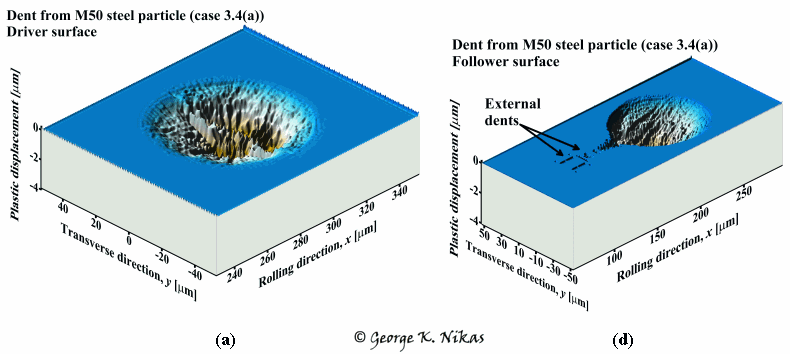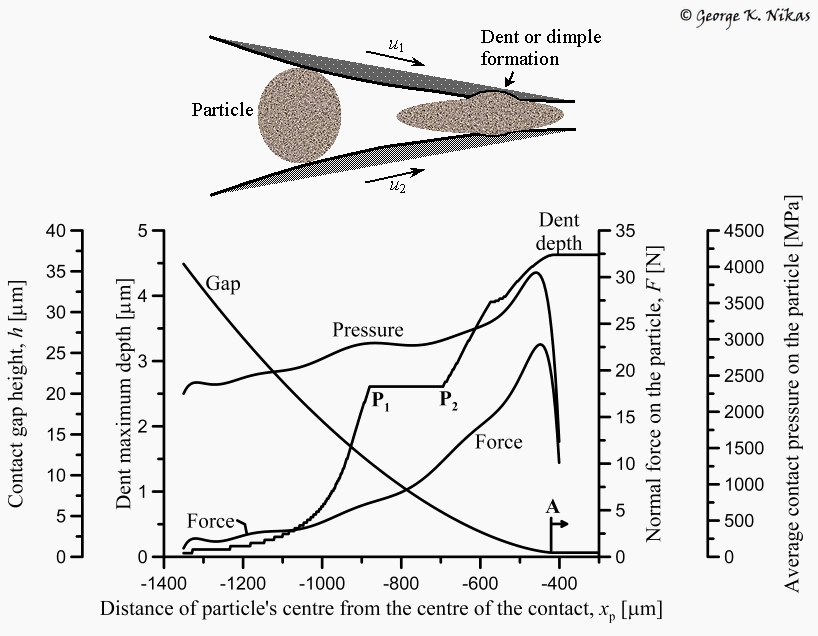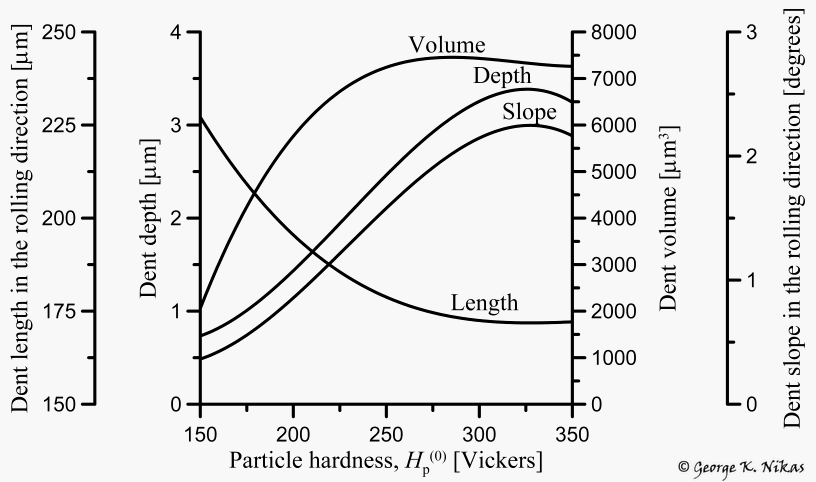
Paper: An experimentally validated numerical model of indentation and abrasion by debris particles in machine-element contacts considering micro-hardness effects.
Author: George K. Nikas
Published
in: Proceedings of the Institution of Mechanical Engineers
(IMechE), Part J: Journal of Engineering Tribology, 2012, 226(5),
406-438
Abstract
Indentation and abrasion of machine-element
contacts by solid contamination particles is a major problem in many
industries and manufacturing processes involving the automotive,
aerospace, medical, and electronics industry among others. Published
theoretical studies on indentation and soft abrasion of surfaces by
ductile debris particles other than those of the author are based on
several major simplifications concerning material properties, hardness,
plasticity modelling, interfacial friction, kinematic conditions, etc.
None of the studies published in the literature to date (2011) has those
simplifications concurrently relaxed.
In view of the shortcomings of existing numerical models on debris particle indentation and abrasion, and given the importance of dent geometry and size on fatigue life of machine elements, a greatly improved numerical model has been developed based on previous studies of the author. The new model deals with elastoplastic indentation and abrasion of rolling-sliding, dry and lubricated contacts by spherical particles of any hardness, from very soft (e.g. 40 HV) to very hard (e.g. over 1000 HV), including harder than the contact counterfaces. The model incorporates strain-hardening and strain-gradient or indentation-size micro-hardness effects with an expanding-cavity plasticity model, a localized treatment of friction, generalized boundary and kinematic conditions involving localised stick and slip of the particle, linear and nonlinear work-hardening models of the particle, a basic approach on pile-up/sink-in plasticity effects, and several other improvements. The model has passed extensive validation tests and found to give realistic predictions that are quantitatively quite close to the experimental results published by independent researchers in the literature concerning dent dimensions and slope. Moreover, it has verified and explained theoretically for the first time the formation of dimples inside and outside dents observed experimentally in rolling and rolling-sliding contacts. This paper presents the mathematics of the model, the validation procedure with several real cases from the experimental literature, and a parametric study to show the modelís predictions on precise dent geometry in several realistic cases.
Some figures from this work
Figure 1 shows one of several examples numerically analysed in the paper, namely the dents generated by a spherical M50 high-carbon steel particle trapped in an elastohydrodynamic, rolling-sliding contact of rotating spherical discs made of AISI52100 steel. This is based on a real case analysed in an experimental study published by Ville and Nelias. Particle and disc hardnesses are almost equal (750 Vickers). The slide-roll ratio between the discs is 6% in this case. Figure 1 shows not only the geometry of the dents but their precise dimensions, which are all in full accord with the experimental results of Ville and Nelias. The simulation confirms for the first time the existence of external dents and bottom holes or dimples inside dents as depicted in figure 1, whose dimensions are also in accord with those measured experimentally.



Fig. 1. Numerical simulation of the indentation of elastohydrodynamically lubricated, rolling-sliding, bearing-steel surfaces by a 36 micron, M50 high-carbon steel particle for 6% slide-roll ratio (this is based on a real case published in an experimental study of Ville and Nelias). Graphs (a) to (c) are for the driver surface; graphs (d) to (f) are for the follower surface.
The paper goes on to demonstrate and explain step by step the process of dimple formation based on a real example. This is shown in figure 2.

Fig. 2. Numerical analysis of dimple formation from a high-carbon steel particle in a rolling, elastohydrodynamic contact of steel spherical discs, based on the experimental results of Ville and Nelias. Dimple formation potentially takes place before point P1 (from left to right). "Gap" refers to the elastohydrodynamic contact gap; "pressure" and "force" refer to those exerted to the particle during its compression in the contact. Finally, point A signifies the entrance to the Hertzian (flat) zone of the contact.
Several examples concerning various particles are analysed in the paper, including copper particles (90 Vickers), low-carbon steel particles (150 Vickers), and high-carbon steel particles (750 Vickers) in rolling and rolling-sliding contacts. All cases are adapted from the experimental literature and the numerical results are thoroughly compared with those derived experimentally.
The paper continues with a parametric study of the effects of particle size, particle initial hardness, strain-hardening properties and friction on the dimensions of dents (surfacial dimensions, depth, volume and average slope). An example is depicted in figure 3.

Fig. 3. Example of the parametric study. Numerical analysis of the effect of particle initial hardness on dent dimensions, volume and slope in the rolling direction.
This paper deals with isothermal elastoplastic compression of ductile debris particles. In a follow-up paper, the important issue of particle frictional heating will be studied in accordance with past work of the author but under the new light of elastoplastic indentation...